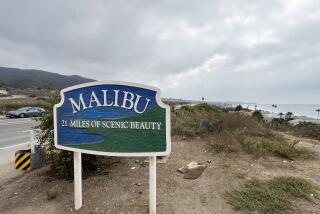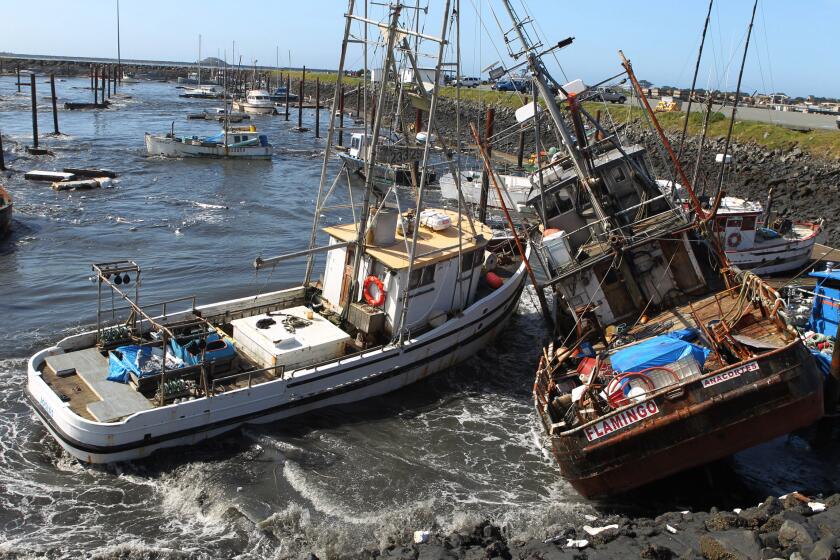North Coast Was Reeling Even Before Earthquakes : Economy: With unemployment high and industries in decline, some towns wonder how they can recover.
- Share via
RIO DELL, Calif. — On the economically ailing North Coast, the weekend’s powerful earthquakes were like being kicked hard three times when you are already down.
Crippled downtowns and tottering Victorians are new economic woes that the old logging and dairy towns in redwood country could do without. The region already suffered from soaring unemployment and swelling welfare rolls, and got a new wallop earlier this month when the commercial salmon season was cut to almost nothing.
The salmon trollers were idled by decree of the federal government, a target of scorn that many also blame--along with state agencies in Sacramento--for the area’s steady decline in logging jobs. Given all the bad news, one local official Monday took a divine message from the trio of quakes.
“The federal government is down on us,” said Humboldt County Supervisor Harry Pritchard, whose district includes some of the hardest-hit towns. “The state government is down on us. And now God is down on us.”
On Saturday morning, a first earthquake of magnitude 6.9 jostled the area. Then early Sunday morning, as unnerved residents tried to sleep, two shocks hit, measuring 6.0 and 6.5. Those shocks did the most damage, apparently because of the type of energy they released.
Still unclear Monday was how the financially strapped region would rebound from the quake toll inflicted in towns like Ferndale, Petrolia and Scotia. Revised estimates put the damage to businesses, homes and public roads and bridges at $51 million.
Although the damage may total more elsewhere, the sense of loss was highest in Rio Dell, a gritty old lumber town that grew up as a poorer relation across the Eel River from the better-tended Scotia, the company town of Pacific Lumber.
Storefront windows all along Rio Dell’s main street are boarded up, and some residents fear there may not be enough life left for the old town to fully recover. “The town is limited on how it can go,” said Gino Bianchi, owner of several of the damaged buildings. “There’s not even a bank . . . because there’s no growth.”
Even before the quakes, Rio Dell’s day had passed, as timber declined as a dominant local industry. Sawmills have shut down or cut their work forces because of overcutting of old-growth forests, efforts to preserve the spotted owl and the economics of the lumber market.
Last year the mills in Humboldt County cut only about a third as much lumber as in their heyday, said John Grobey, professor of economics at Humboldt State University. He and others said the best hope for some of the small towns may lie in “equity refugees” who move here from urban California with real estate profits in their pockets, looking for a safer, nicer place to live.
“If they can stand the summer fog and the rain, they can live very well,” Grobey said. “There has been quite a bit of that.”
In Scotia, Pacific Lumber announced it would rebuild the town’s four-store mall that survived the first quake but burned down after the aftershocks. The mall included the town’s only pharmacy, hardware store, coffee shop and grocery.
Cindi Buck, whose husband worked at the firm’s idled mill, said provisions are available in other towns but that the local stores will be missed.
“I have done grocery shopping at the mall all my life,” Buck said. “The worst part is that we knew everyone who worked here. My mom worked in the hardware store.”
Pacific Lumber, the county’s largest private employer, on Monday was forced to temporarily shut its two Scotia sawmills because of earthquake damage. Employees reporting for duty were put to work restacking tumbled boards and rearranging jostled machinery. The company has 700 employees in Scotia.
Company spokeswoman Mary Bullwinkel said that executives hope to avoid layoffs, but it could be weeks before the Scotia mills are repaired and operating again. Pacific Lumber mills in Fortuna and Carlotta that employ about 550 workers are operating normally.
In nearby Ferndale, weary residents were treated to a noontime barbecue Monday with food donated by local butchers and grocers. For some, it was the first first hot meal since the quakes rolled through and knocked dozens of Victorian homes off their foundations.
Katy Stadter ate steak and beans with her two sons and was thankful for the break. “Our house didn’t fall down but we’re tired,” she said. “We’ve slept the last two nights in our back yard.”
Ferndale, a state historic landmark because of the well-preserved buildings, was a mainstay of the local tourist trade. Before the quakes, tourism was a rare bright economic spot, growing at a 6% annual rate despite the national recession, said Dona DePaoli, executive director of the Eureka/Humboldt County Convention and Visitors Bureau.
But with the national exposure given to television footage of leaning Victorians and tourists in Bermuda shorts running in the streets, the prospects for summer do not look as good.
“We don’t know whether people will come,” said Norma Bessingpas, owner of the 138-year-old Shaw House Inn, the oldest building in Ferndale. But not everyone was scared off, she said: “We have had calls for reservations in July.”
Meanwhile, scientists from the U.S. Geological Survey and Stanford University said Monday that the aftershocks occurred on a different fault and radiated a more damaging form of energy than the earlier, more powerful main quake.
Greg Beroza, professor of geophysics at Stanford, said that because of its higher-frequency energy waves, the 6.5 aftershock at about 4 a.m. Sunday did much more damage than Saturday’s 6.9 main shock.
Beroza and David Oppenheimer, a seismologist with the U.S. Geological Survey in Menlo Park, said that the 6.9 main shock occurred on an unnamed fault onshore near the village of Petrolia and was a thrust earthquake in which the Gorda tectonic plate forced its way under the North American plate.
Beroza and Oppenheimer said that stress transferred from the main shock probably generated the aftershocks on another unnamed fault on the Gorda plate, 15 miles out in the Pacific, that had not moved in the first earthquake.
The aftershocks were more common strike-slip earthquakes, where the two sides of the fault slide past each other horizontally, they said. The aftershocks may have conveyed their energy much more directly at the damaged towns.
“The second (more powerful) aftershock had a very short duration, consistent with a high rupture velocity or (with) the slip happening over a small fault rather than a large one,” Beroza said. “It had exactly those high frequencies that people perceive, and that damage buildings.
Times staff writers Paul Feldman in Humboldt County and Kenneth Reich in Los Angeles contributed to this story.
* POLITICAL JOLT: The temblors came during a push for repeal of state quake recovery program. A3
More to Read
Sign up for Essential California
The most important California stories and recommendations in your inbox every morning.
You may occasionally receive promotional content from the Los Angeles Times.














